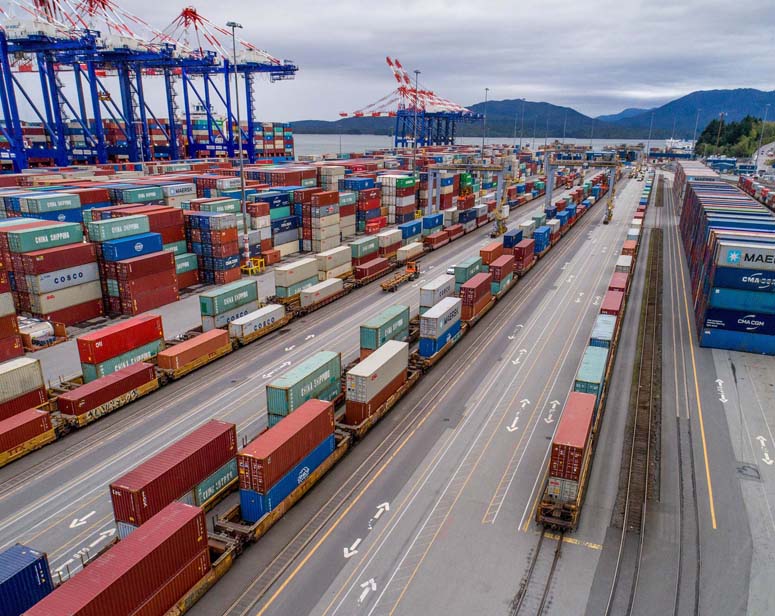All about the community of model railroading and rail enthusiasm
July 4, 2023 / Updated August 14, 2023

UPDATED/From News Releases
A month-long strike of port workers in Western Canada ended in early August, restoring container traffic to two of the country’s busiest gateways.
International Longshore & Warehouse Union Canada members voted nearly 75 percent percent in favor of a settlement with the BC Maritime Employers Association.
The strike of about 7,500 workers representing the ILWU disrupted operations for 35 days at the Port of Vancouver and the Port of Prince Rupert, where Class I railroads Canadian Pacific Kansas City and Canadian National move a significant number of intermodal containers. BNSF Railway serves the Port of Vancouver.
ILWU president Rob Ashton issued a statement on Aug. 4 saying that the “results of the ratification vote for the tentative agreement show 74.66 percent in favour of accepting the terms of the settlement.”
BCMEA said in a statement that the renewed collective agreement includes “increases in wages, benefits and training that recognizes the skills and efforts of B.C.’s waterfront workforce, while providing certainty and stability for the future of Canada’s West Coast ports.”
The statement also said BCMEA “recognizes and regrets the profound repercussions this labour disruption has had on the national economy, workers, businesses and ultimately, all Canadians that depend on an efficient and reliable supply chain.”
Millions of dollars in trade have been disrupted since the strike began in late June. Intermodal traffic in Canada suffered throughout the strike. From July 1 through Aug. 5, intermodal units were down 326,531 or 17.5 percent for the same period in 2022, according to the Association of American Railroads. Two weeks into the strike through July 15, traffic plummeted 36.3 percent.
In a message July 2023, Railway Association of Canada president Marc Brazeau noted that the strike that began on Canada Day paralyzed Western ports.
“This created created major backlogs across supply chains that could take several months to fully recover,” he said.
BCMEA hopes workers and union leaders can move forward and resolve any future disputes to avoid disrupting the supply chain.
“All supply chain stakeholders must collaborate now to ensure we do not see disruptions like this ever again,” BCMEA said. “Whether in Halifax, Montreal, or the Pacific Gateway, Canadians are relying on us – employers, unions, and the federal government – to keep goods flowing and ensure supply chain stability and resilience for the future.”
ILWU and BCMEA, which represents port owners, argued mainly over automation, contract work and cost of living. They began negotiating Feb. 16 and were involved with Federal Mediation and Conciliation Services since April.
The strike appeared over in mid-July when labor leaders tentatively reached a new agreement, but workers rescinded the deal.
At one point, BCMEA said it had “gone as far as possible on core issues” and that change in course is needed. “ILWU Canada went on strike over demands that were and continue to be outside any reasonable framework for settlement. Given the foregoing mentioned, the BCMEA is of the view that a continuation of bargaining at this time is not going to produce a collective agreement.”
Ashton said the union had bargained in good faith and hoped the parties can reach an accord soon.
“We implore the BCMEA to get back to the table to achieve a fair and reasonable agreement that the parties negotiate together,” he said in a statement. “It is unrealistic to think that a collective agreement that is imposed will result in long term labor stability in the industry. The parties need to put their best effort forward for the entire country and not just their individual aims. We hope that the Association is not hiding behind the threat of back to work legislation and binding arbitration to avoid engaging in bargaining with the Union.”
According to insights from marine traffic reported July 1 by Container xChange, 150-plus vessels were in the Port of Vancouver and another 55 were scheduled. At the Port of Prince Rupert, 60-plus vessels were waiting, with another 25 on the way.
CNBC reported that the value of the combined 181,458 containers floating off Vancouver and Prince Rupert reached $12 billion, based on $65,225 in goods per container and Canadian customs data.
Container xChange, an online container shipping platform, said the delays could impact vessel transit and dwell times, which could drive up shipping costs and mean higher prices for consumers.
“The strike could have a significant impact on the ports of Vancouver and Prince Rupert, which are crucial gateways for Canada’s foreign trade, especially with Asia,” said Christian Roeloffs, cofounder and CEO of Container xChange. “These ports handle a substantial portion of Canada’s imports and exports. The disruption caused by the strike can lead to delays, congestion, and inefficiencies in the movement of cargo, affecting various industries and businesses that rely on the smooth functioning of the supply chain.”
Container xChange anticipates that the strike would negatively impact what little cargo volume growth the Port of Prince Rupert has enjoyed this year. Cargo volumes at Prince Rupert grew by 2 percent from 2,115,270 tons in May 2022 to 2,158,316 ton in May 2023.
At the Port of Vancouver, prices have consistently deteriorated on a month-on-month basis since February 2022 when they peaked at $5,460. Average container prices continued to slide, from $1,769 in May 2023 to $1,711 in June 2023.
The strike threatened to further disrupt intermodal traffic on Canadian and U.S. railroads.
AAR reported that North American intermodal units were down 10 percent year to date ending June 24. For the same period, Canadian intermodal units dropped 9.1 percent to 1,721,415.